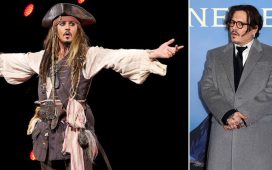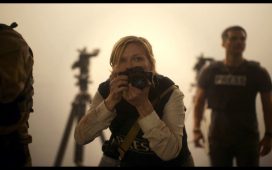It doesn’t take long into Rachel Griffiths’ debut directorial feature film, Ride Like a Girl, to be struck by the realisation that this is play-to-the-bleachers entertainment, loaded with Hallmark sentiment and configured with an atmospheric integrity a cut above a soft drink commercial.
It is a biopic of Michelle Payne from central Victoria who, in 2015, became the first female jockey to win the Melbourne Cup. The film reaches a high-water mark of cinematic schmaltz in, well, water, during a sequence capturing Payne (Teresa Palmer) connecting with “the one” – her horse, Prince of Penzance. This takes place on a beach and is captured in long shots, with small waves and globs of sea foam rolling gently into the shore while panpipes play on the soundtrack. I wouldn’t have blinked if the voice of Daryl Braithwaite had been injected into this moment, crooning that song about odd-toed ungulates running in the clouds.
“The only thing that matters are the odds you give yourself,” Payne’s father Paddy (Sam Neill) tells his daughter, going on about something called “the gap” – which apparently is the all-important moment during which a horse race is won or lost. You can probably guess which big event Payne is psyching herself up for when dad’s words return to her mind and travel through the speakers once more, highlighting the bit in the script marked “he’s with you in spirit”.

Somewhere, at the back of all this, there are the bones of an uplifting story about Payne, who pursued her dreams with grit and tenacity, overcoming great physical and mental hardship. The best part of Ride Like a Girl is Teresa Palmer’s portrayal of her. Palmer is an actor with a great presence and a commanding ability to project inner strength. There is also a small but sweet performance from Payne’s real-life brother Stevie, who has Down’s syndrome and plays himself.
By the point at which Paddy’s sage advice has returned via voice-over, various other wishy-washy moments have transpired, in a film drawn to mawkish sentiment as if by magnet. These include training montages set to subtext-spelling songs such as the Cranberries’ Dreams (“Oh my life, is changing every day … ”).
Clearly marketed as inoffensive feel-good pap, I didn’t go into the film expecting a nuanced commentary on the racing industry. But nor did I expect what often felt like a thinly veiled 98-minute advertisement, interspersed with occasional moments of warmth and humanity.

Immediately after the credits rolled, I wondered aloud to my companion whether the film was a puff piece for the horse racing industry. An industry that is well-connected to politicians, mired in controversies and frequently accused of cruelty to animals, both in Australia and overseas. Indeed, animal rights activists stormed its premiere screening, reportedly interrupting speeches and being dragged away by security – though the cinema I attended was free of the real-life drama.
When I asked whether Ride Like a Girl was financed by the racing industry, the film’s producer, Richard Keddie said: “Racing Victoria and TabCorp supported the production of the film through a sponsorship arrangement with the producers. They had no editorial control or influence over the content of the film.”
The film’s moments of humanity occur in scenes exploring the relationship between Payne, Paddy and Stevie (the family consisted of 10 children, all of whom, other than Payne and Stevie, receive little screen time). One scene contains a sneeze-and-you’ll-miss-it reference to a protest happening outside a race track, but that’s it when it comes to acknowledging anything remotely untoward about the horse racing industry. This is a film that cares for animals only in terms of their ability to adorn pretty sunshine-tinted pictures.
The idea that you cannot make an inspiring movie set in the Australian horse racing industry while also being truthful is, by the way, demonstrably untrue. The 1983 film Phar Lap explores a national icon and shows a beautiful side to horse riding, but doesn’t turn a blind eye to the grim realities of racing.

What did surprise me, however, was Ride Like a Girl’s meekness as a commentary on gender bias and sexism within the racing industry. I assumed this would be core to its premise, but the film-makers evidently felt otherwise. Several scenes depict Payne in rooms full of men, and there’s one moment in which she is told that the official odds of her winning are “100 to one” but “you’d be half that if you were a bloke”.
There is little else, other than a general sense of a woman toiling away in a male-dominated industry. It’s as if the film-makers were afraid of making a point about systematic sexism and the oppressive state of the patriarchy. Griffiths and her screenwriters, Andrew Knight and Elise McCredie, seem to have stuck their fingers in their ears, stripping the film of almost anything that might be considered remotely political or provocative.
Ride Like a Girl is based on a real story, but little about it rings true. I came out of the cinema feeling bloated, as if I’d wolfed down a chunk of cheddar the size of a car battery.
• Ride Like A Girl is out in Australian cinemas on 26 September













